PICASSO Ceramics: The Modern Touch
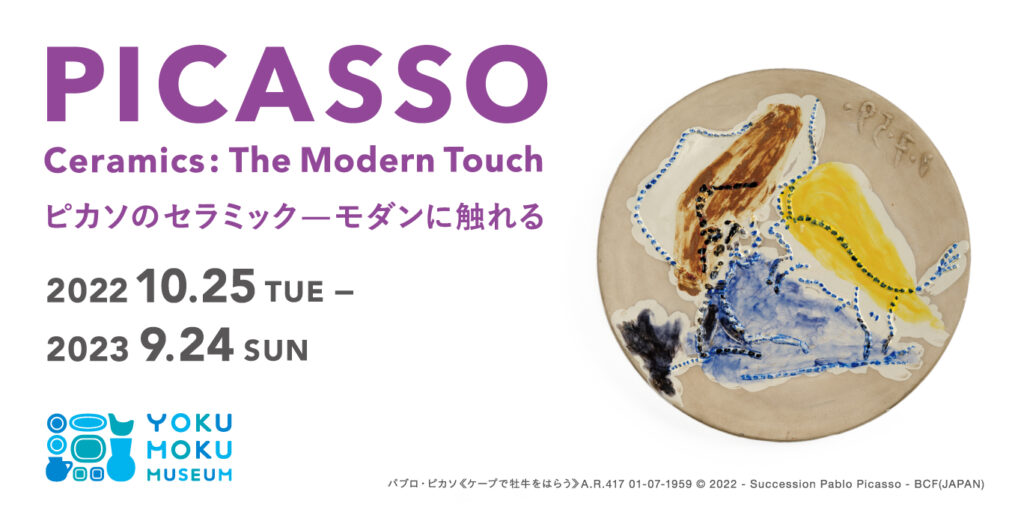
Information
Exhibition title:Picasso Ceramics: The Modern Touch
Supervision of the Exhibition:Mari Komoto (Professor, Japan Women’s University)
Venue, Organizer:YOKU MOKU MUSEUM
Exhibition period:Tuesday, October 25, 2022 ‒ Sunday, September 24, 2023
Closed:
Mondays (or if a holiday falls on a Monday, the following Tuesday), year-end and New Year’s holiday period, and exhibition-installation periods
Opening hours:
10:00 a.m. to 5:00 p.m. (last admission 30 minutes prior to closing time)
Nominal support:Minato City board of education
Special Cooperation: YOKU MOKU Co., ltd.
Admission Fee (tax included)
Ordinary ticket ¥1,200
Students ¥800
Elementary-school students and younger children Free
※If a visitor presents a disabled person’s identification card, he or she, along with one
accompanying guest, may enter free of charge.
Exhibition Overview
Picasso Ceramics: The Modern Touch is the third exhibition organized by the YOKU MOKU MUSEUM to introduce new perspectives on its collection. Supervised by Mari Komoto, professor of Japan Women’s University and a leading authority on Picasso and twentiethcentury art, this exhibition offers an in-depth analysis and re-assessment of the ceramics of Picasso in terms of modernity – specifically, Picasso’s fusion of ‘the modern’ and ‘the classical.’
As explored in the Museum’s previous exhibitions, Picasso: Life on the Côte d’Azur
(10.25/2020 – 9/26/2021) and Picasso The Mediterranean: Enjoying the Mythical World
(10/26/2021 – 9/25/2022), Picasso’s post-World War II ceramic works are often discussed in relation to the ceramic traditions, and the inspiration of mythology and the ancient art of the Mediterranean region. Though this is certainly an important aspect of the Picasso ceramics, the upcoming exhibition takes a different approach.
Picasso incorporated Cubist still life and visage themes in his ceramic works and, as in his collage and found object constructions, exploited the opposition of reality and illusion. Picasso’s late-life ceramic practice maintains continuity with the Cubist style he invented in his youth.
Picasso created “vases within vases” and transfigured vases into female forms and
(abstract) birds. He also attempted to depict the weightless movement of dancers and
athletes despite the rigid sensation of ceramics as a material. Though the representation of dance and movement in art has endured as a theme since ancient times, Picasso’s extreme reduction of form and stylization highlight his particular modern rendition of this motif.
Picasso’s innovative reinterpretation of classical themes in his ceramic works infuses them with an undercurrent of modernity.
This exhibition, by positioning Picasso ceramics within the context of twentieth-century art, introduces a fresh vision of the YOKU MOKU MUSEUM collection. Visitors are encouraged to experience the diverse and playful universe of Picasso’s art.
Exhibition Structure: Three Sections
Section I: Cubism and the Question of Reality and Illusion
Cubism, an artistic movement invented by Picasso as a young man at the beginning of the twentieth century, served as foundation for his subsequent art. By deconstructing threedimensional objects and reassembling them in a two-dimensional plane, the Cubists created bold configurations in flat, fragmented, geometric compositions. In this process, they also invented the collage and papier collé. The movement came to play a pivotal role in the art of the twentieth century onward.
This section features ceramics decorated with Cubist still lifes and visages as well as works that playfully juxtapose reality and illusion (i.e. fish painted on plates) in a manner similar to Picasso’s collages and found object constructions. Also introduced here are works that create a kind of camouflage effect by separating an object’s form (contour) and color, making it difficult to readily identify what is being represented.
Section II: Playful Metamorphosis
Picasso viewed ceramics as a medium that, like painting and sculpture, allowed him playful experimentation. This section introduces the various aspects of his playfulness in ceramics.
Picasso brought into question the very structure of a vase, for example, creating “vases
within vases.” His free transformations of vases into female figures and (abstract) birds are particularly remarkable as manifestations of his faculty for metamorphosis.
In his later years, Picasso developed ‘series’ with common imagery across painting,
printmaking, and ceramics. His variations inspired by Edouard Manet’s Luncheon on the
Grass were produced in paintings and prints, and also in ceramics – a version of which is
featured in this exhibition.
In this section, we can also observe and interesting example of the enhancing effect,
whether intended by Picasso or not, of the ‘aesthetic of defects,’ the element of the
‘accidental’ that commonly occurs in ceramics.
Section III: Ceramics and Dance
Artists have obviously been depicting dance and movement since ancient times. It was a
major focus of the Impressionists and Post-Impressionists of the nineteenth century, as well as for Henri Matisse and the Futurists of the twentieth century. Picasso’s designs for ballet and his painting The Three Dancers (1925) reflect his interest in these themes. Turning to ceramics in his later years, Picasso attempted to capture the weightless movement of dancers and athletes in this medium that is often viewed as solid and rigid.
This section sheds light on a series of Picasso ceramics that explore dance and movement, showing the artist’s modern reinterpretation of these themes. Picasso reduced the figures of dancers to simplified symbols, barely more than pictograms, and he could create the figure of an athlete by cutting out a shape from a sheet of paper and then folding it.
This final section examines as well Picasso’s Joy of Life, an important painting representing dance that is suggestive of the post-World War II utopian ideal of art and society.
Supervision of the Exhibition: Mari Komoto
Born in 1968 in Tokyo. Komoto holds a Ph.D. from the University Paris 1 Panthéon-Sorbonne. Her research field is the history of modern and contemporary art. She is currently professor (art history) at Japan Women’s University. She is the author of The Era of Discontinuity: Aesthetics and History of Collage in the Twentieth Century (Tokyo: Brücke, 2007, for which she won the Suntory Prize for Social Sciences and Humanities and the Shibusawa-Claudel Special Prize), Forms in Conflict: The First World War and Arts (Kyoto: Jimbun Syoin, 2011), co-author of The Iwanami History of the First World War, Vol. 3, The Transformation of Mind (Tokyo: Iwanami Syoten, 2014), Picasso and Art for Humanity (Tokyo: Sangensha, 2020).
Number of works exhibited: 32 works(Including the special exhibit Les Gâteaux, 1937, oil on canvas)
*Other reference exhibits available.
Events:(to be announced on the official website as required):
・Lectures
・Gallery talk
*Contact us about school group visits.
・Learning programme Picasso de Art
・Concurrently: Permanent exhibition 2022-2023
Products:
・Catalogue
・Worksheet for children
・Picture postcard
*Other items include a list of exhibits (for distribution).
Images of exhibited works (selected):
Image① (main visual, poster, flyer and catalogue cover) (Section I)
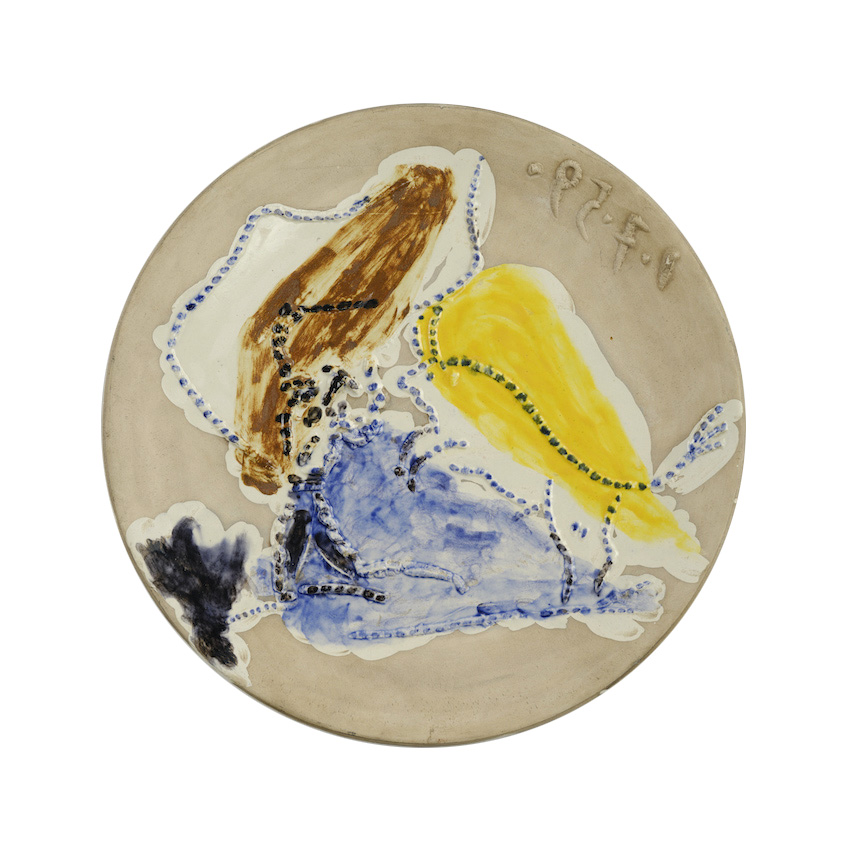
Pase de capa
1959/7/1
Empreinte originale, white earthenware, decorated with colored slips, partial transparent glaze, beige patina
4 × 42(cm, diam)
Pablo Picasso,Pase de capa,A.R.417,01-07-1959
Image② (flyer) (Section I)
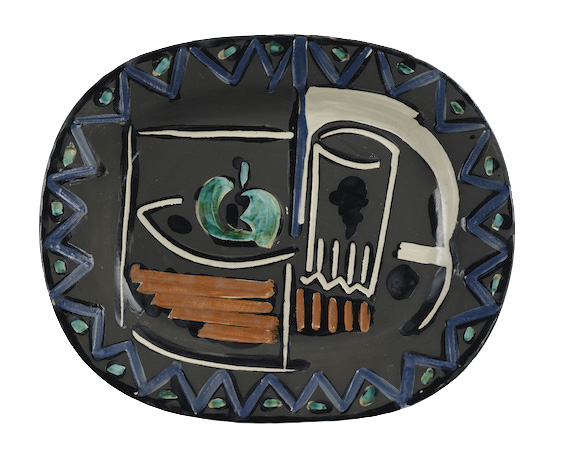
Still Life
1953
Press-molded white earthenware, decorated with colored slips, incised, transparent glaze
4 × 39 × 31 cm
Pablo Picasso, Still Life,A.R.219,1953
Image③ (flyer) (Section I)
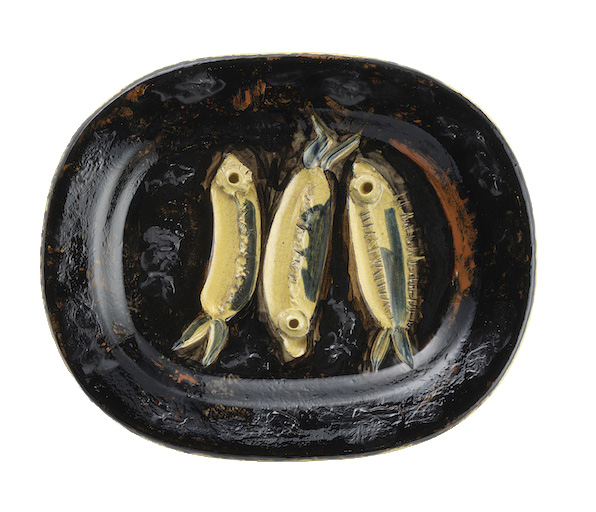
Three Sardines
1948
Press-molded white earthenware, decorated with slips, incised, material added, transparent glaze
4.7 × 37 × 30.5 cm
Pablo Picasso, Three Sardines,A.R.34,1948
Image④ (flyer) (Section II)
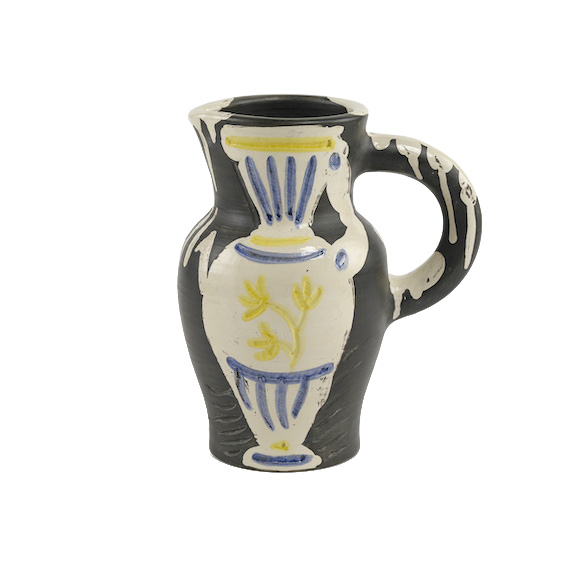
Jug with Vase
1954/1/12
Thrown white earthenware, decorated with colored slips, incised, partial transparent glaze
30 × 26 × 18 cm
Pablo Picasso, Jug with Vase,A.R.226,12-01-1954
Image⑤ (flyer) (Section II)
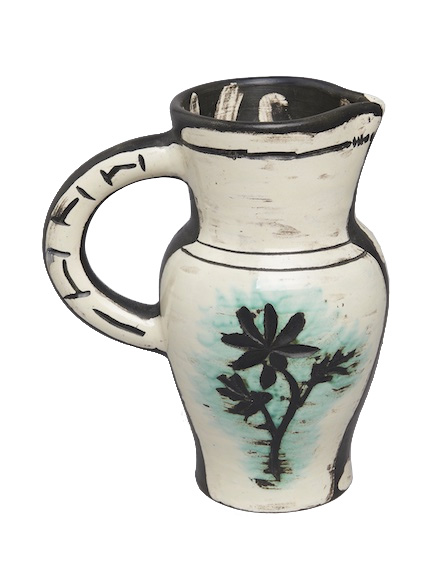
The Source
1954/1/11
Thrown white earthenware, decorated with slips, incised, partial transparent glaze, black patina
30 × 25 × 16 cm
Pablo Picasso, The Source, A.R.225,11-01-1954
Image⑥ (flyer) (Section III)

*Different aspects of one work
Dancers and Musicians
1950
Empreinte originale, pink earthenware, incised, decorated with slip
70.5 × 33 × 32.5 cm
Pablo Picasso, Dancers and Musicians,A.R.114,1950
Image⑦ (flyer) (Section III)
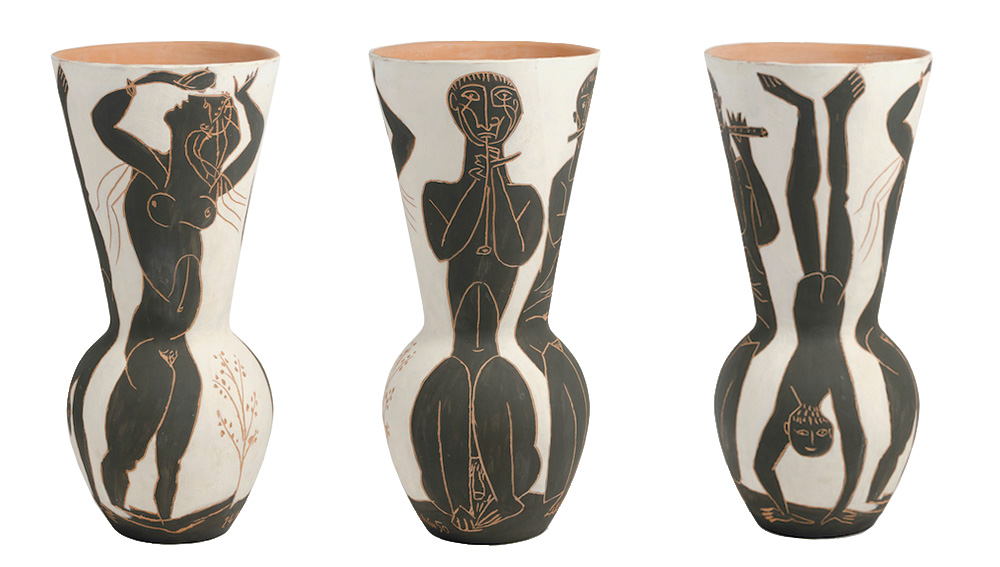
*Different aspects of one work
Dancers and Musicians
1950
Empreinte originale, pink earthenware, incised, decorated with slip
70.5 × 33 × 33 cm
Pablo Picasso, Dancers and Musicians,A.R.114-B,1950
Image⑧ (flyer) (Section III)
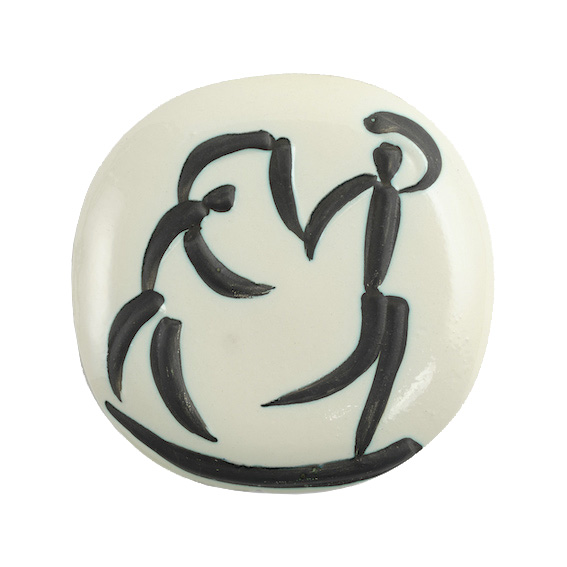
Dancers
1956
Empreinte originale, white earthenware, decorated with oxide, wax resist, transparent glaze
1.5 × 18.7 (cm, diam)
Pablo Picasso, Dancers,A.R.387,1956
Image⑨ (flyer) (Section III)
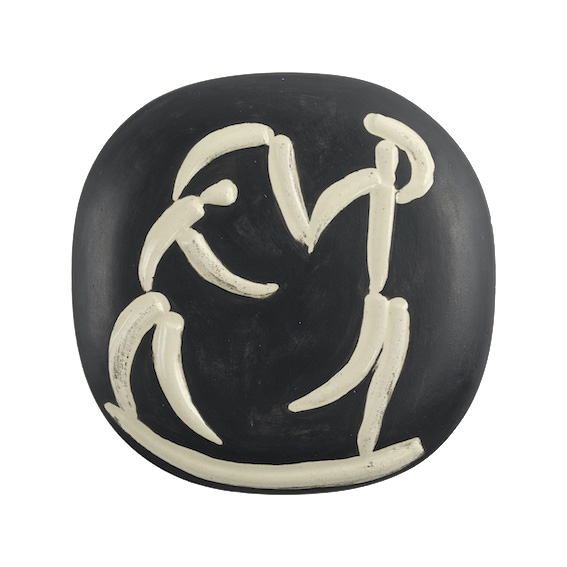
Dancers
1956
Empreinte originale, white earthenware, decorated with slips
1.3 × 19 (cm, dimm)
Pablo Picasso, Dancers, A.R.388,1956
ⓒ2022-Succession Pablo Picasso-BCF(JAPAN)
